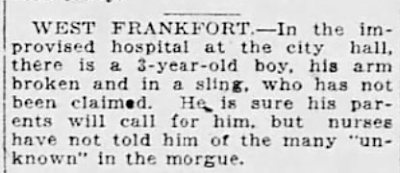One hundred years ago, on 18 March 1925, the United States’ deadliest tornado roared through Missouri, southern Illinois, and southern Indiana. When it was all over, 695 people were dead, over 2000 more were injured, and 15,000 homes were destroyed. Known as the Tri-State Tornado, this F5 storm destroyed entire towns as it made its way for over 200 miles. It lasted for almost four hours before it finally died out.
Late in the afternoon, the “Black Monster,” as some newspapers called it, struck Franklin County, Illinois. It directly hit the town of West Frankfort, destroying the northwest part of town. West Frankfort was a town I knew well — both my parents grew up there, but my great-grandparents hadn’t yet moved from Iowa. My mother’s family lived on farms and in small communities outside town.
As the storm hit West Frankfort, it destroyed Central School. The windows shattered, and everything crumbled. Children hid under their desks, and many were buried under the rubble for hours before being rescued. Parents raced to the school — some found their children alive. Others were not so lucky - at least 15 children were dead.
In the town of Orient, the Orient No. 2 coal mine was destroyed, killing many miners. While being in the mines provided some protection from the storm, the apparatus and buildings above ground were all destroyed. The tornado hit as a shift was ending. Miners coming to the surface were hurled into piles of rubble. Survivors described walking through the wreckage and seeing twisted steel and bodies. Many miners who had been underground throughout the storm came to the surface only to find their homes destroyed and their families dead.
The tornado destroyed entire neighborhoods throughout the county. Telegraph lines, railway facilities, and other infrastructure were devastated impacting communication and delaying rescue efforts. Families started the search for their missing loved ones, digging through the rubble with their bare hands and whatever tools they could find.
Medical staff was overwhelmed with the number of casualties. Makeshift medical facilities were set up in undamaged buildings, including the high school in West Frankfort. Doctors arrived from nearby towns, but the damage to roadways and rail facilities made it hard to get into town. Buildings were turned into makeshift morgues. Families had the sad task of identifying their loved ones. Local funeral homes were overwhelmed, and funeral homes throughout southern Illinois offered assistance. Some were buried in mass graves.
A particularly sad story was noted in a newspaper article.
After the storm, a downpour hit the devastated areas. Most of the streets were unpaved then, and the mud further impacted the rescue efforts. The Red Cross arrived the next day to distribute food and clothing and provide medical aid. The National Guard was deployed to prevent looting and help with the cleanup. Martial law was briefly instituted but not needed. Hundreds of families lived in tents for weeks after the tornado while housing was rebuilt. At the time, there was no formal disaster relief. Help came from private donations, charity, and fundraising. The mining companies helped to rebuild homes for their workers.
Throughout the county, more than 150 people lost their lives,
including at least 40 small children. Many people left the area after the storm
and did not return. But the community came together to rebuild and recover. My
grandparents moved to West Frankfort within a couple of years after the tornado
— my dad was born there at the end of 1929. My grandparents remained there for the rest of their lives.
This week's #52 Ancestors prompt is Historic Events.
.jpg)

